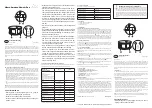
EES3 Hardware Interface Description
3.15 Audio Interfaces
71
EES3_HD_v01.100b
Page 60 of 118
2009-08-12
Confidential / Released
3.15.1
Speech Processing
The speech samples from the ADC or DAI are handled by the DSP of the baseband controller
to calculate e.g. amplifications, sidetone, echo cancellation or noise suppression depending on
the configuration of the active audio mode. These processed samples are passed to the
speech encoder. Received samples from the speech decoder are passed to the DAC or DAI
after post processing (frequency response correction, adding sidetone etc.).
Full rate, half rate, enhanced full rate, adaptive multi rate (AMR), speech and channel encoding
including voice activity detection (VAD) and discontinuous transmission (DTX) and digital
GMSK modulation are also performed on the GSM baseband processor.
3.15.2
Microphone Circuit
EES3 has two identical analog microphone inputs. There is no on-board microphone supply
circuit, except for the internal voltage supply VMIC and the dedicated audio ground line AGND.
Both lines are well suited to feed a balanced audio application or a single-ended audio appli-
cation.
The AGND line on the EES3 board is especially provided to achieve best grounding conditions
for your audio application. As there is less current flowing than through other GND lines of the
module or the application, this solution will avoid hum and buzz problems.
While EES3 is in Power-down mode, the input voltage at any MIC line must not exceed ±0.3V
relative to AGND (see also
). In any other operating state the voltage applied to any
MIC line must be in the range of 2.4V to 0V, otherwise undervoltage shutdown may be caused.
Consider that the maximum full scale input voltage is V
pp
= 1.6V.
If VMIC is used to generate the MICP line bias voltage as shown in the following examples con-
sider that VMIC is switched off (0V) outside a call. Audio signals applied to MICP in this case
must not fall below -0.3V.
If higher input levels are used especially in the line input configuration the signal level must be
limited to 600mV
pp
outside a call, or AT^SNFM=,1 should be used to switch on VMIC perma-
nently.
















































